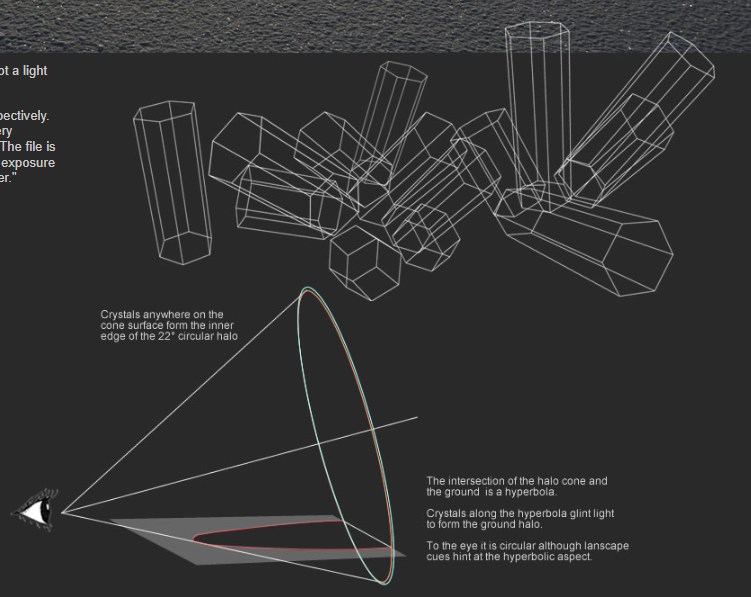OPOD - Ground Halo, Norway
OPOD - Ground Halo, Norway: Exploring the Phenomenon in Detail
The enchanting beauty of atmospheric optics never fails to captivate us, and one such mesmerizing phenomenon is the ground halo. Recently, Lars Brub�k had the opportunity to witness and photograph a perfect 22° ground halo on Lake Fosterl�gen, near Molde, Norway. In this blog post, we will delve deeper into the intricacies of ground halos and explore their fascinating characteristics.
Similar to its celestial counterpart, the 22 degree radius ground halo is formed by sunlight reflecting off countless hexagonal prism ice crystals. These ice crystals, which may be individual or part of cluster crystals, are randomly or near-randomly oriented. As the sunlight hits these crystals, they create glints of light that collectively form the ground halo.
Contrary to popular belief, the ground halo is not a simple ring but a captivating circle of light. The inner edge of the halo appears colored and spans a radius of 22° around the sun. However, the halo extends much further beyond this radius. The glints of light serve as vivid evidence that the halo's reach is not limited to a mere ring.
When viewed with an unbiased eye or camera, the ground halo appears as a circular shape. This characteristic holds true regardless of the distance at which the glinting crystals are located. Just like rainbows, halos maintain their size and shape regardless of the position of the reflecting particles (in this case, ice crystals). However, when visual landscape cues are introduced, the ground halo reveals hints about the path of the light specks on the ground.
Interestingly, the ground halo's interaction with the landscape gives rise to a hyperbola-like shape. This shape is formed by the intersection of the ground plane with the section of the 22° half-angle halo cone. The landscape cues provide an additional layer of complexity to the ground halo, transforming it from a simple circular phenomenon to a visually captivating spectacle.
Now that we have explored the basics of ground halos, let's take a moment to appreciate the intricate details of Lars Brub�k's photograph. The serene setting of Lake Fosterl�gen, blanketed with a light dusting of snow, provided the perfect backdrop for capturing the sparkling ground halo. Lars skillfully composed the shot, ensuring that the halo took center stage and became an undeniable eye-catcher.
Lars's photograph serves as a testament to the ephemeral nature of atmospheric optics. The cold spell, absence of clouds, and light snowfall combined to create the ideal conditions for the formation of the ground halo. Such moments of natural beauty remind us of the delicate balance between atmospheric conditions and the awe-inspiring phenomena they give rise to.
In conclusion, the ground halo is a captivating atmospheric optics phenomenon that mirrors its celestial counterpart. The collective glints of sunlight reflecting off ice crystals form a circular halo, extending far beyond its inner colored edge. When viewed in conjunction with visual landscape cues, the ground halo takes on a hyperbola-like shape, adding an extra layer of complexity to its appearance. Lars Brub�k's photograph beautifully captures the essence of this phenomenon, reminding us of the enchanting wonders that can be found in our natural surroundings.

Ground Halo, Norway
Lars Brub�k pictured this perfect 22° ground halo on Lake Fosterl�gen, near Molde, Norway.
"We had had a long cold spell, no clouds or precipitation except a light dusting of snow on the previous night.
My wife and I were on the lake, kick sledding and skating, respectively. As we got near the lake, this sparkling ground halo became very obvious, a true eye-catcher. I took several photos, this is one. The file is made from one exposure, hand-held. Treatment in Lightroom: exposure reduced 1,55 steps, colour temp adjusted a trifle towards colder."
©Lars Brub�k, shown with permission.

Like its counterpart in the sky, the 22 degree radius ground halo is the collective glints of sunlight from innumerable hexagonal prism ice crystals. They are randomly or near randomly oriented. The hexagonal prisms might be individual crystals or components of cluster crystals.
The glints give vivid proof that the halo is not a ring. Its inner coloured edge is 22° radius but it actually extend far further from the sun.
To the unbiased eye or camera the halo is a circle. Halos, like rainbows, have the same size and shape regardless of the distance of the glinting crystals (or in the case of rainbows -raindrops). But.. ..add visual landscape cues and the halo hints at the path of the specks of light on the ground, a hyperbola, the section of the 22° half angle halo cone produced by the intersection of the ground plane.
Note: this article has been automatically converted from the old site and may not appear as intended. You can find the original article here.
Reference Atmospheric Optics
If you use any of the definitions, information, or data presented on Atmospheric Optics, please copy the link or reference below to properly credit us as the reference source. Thank you!
-
<a href="https://atoptics.co.uk/blog/opod-ground-halo-norway/">OPOD - Ground Halo, Norway</a>
-
"OPOD - Ground Halo, Norway". Atmospheric Optics. Accessed on December 27, 2024. https://atoptics.co.uk/blog/opod-ground-halo-norway/.
-
"OPOD - Ground Halo, Norway". Atmospheric Optics, https://atoptics.co.uk/blog/opod-ground-halo-norway/. Accessed 27 December, 2024
-
OPOD - Ground Halo, Norway. Atmospheric Optics. Retrieved from https://atoptics.co.uk/blog/opod-ground-halo-norway/.